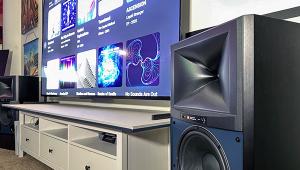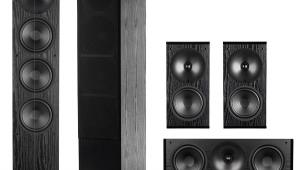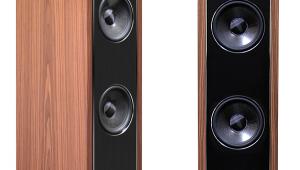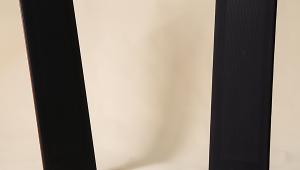Test Report: Paradigm Monitor Series 7 Speaker System Page 3
Bottom Line
Paradigm has remained in the loudspeaker performance/value forefront for decades, a position that’s not going to change with the Monitor Series 7. Most people wouldn’t consider a $3,400 speaker system “cheap” by any definition, but we’re not most people, and the Paradigm system reviewed here is ridiculously good for that figure. It delivers natural tonal balance, serious bass extension, impressively clean dynamic range and transient punch, and tight, stable imaging in generous, well-balanced measure, with cosmetics and fit’n’finish that will satisfy most and should offend none. Unhesitatingly recommended.
Test Bench
Frequency response
• tower: 47 Hz to 20 kHz ±4.6 dB
• center: 62 Hz to 20 kHz ±4.8 dB
• surround: 81 Hz to16.3 kHz ±4.8 dB
• subwoofer: 32 to 168 Hz ±3 dB
Sensitivity (SPL at 1 meter/1 watt)
• tower: 87.7 dB
• center: 88.3 dB
• surround: 87.0 dB
Impedance (minimum/nominal)
• tower: 3.3/6 ohms
• center: 3.1/6 ohms
• surround: 3.8/7 ohms
Bass output, tower (CEA-2010 standard)
• Ultra-low bass (20-31.5 Hz) average: 87.4 dB
20 Hz: 77.1 dB
25 Hz: 86.0 dB
31.5 Hz: 99.2 dB
• Low bass (40-63 Hz) average: 115.0 dB
40 Hz: 115.0 dB
50 Hz: 115.9 dB
63 Hz: 114.3 dB
Bass output, subwoofer (CEA-2010 standard)
• Ultra-low bass (20-31.5 Hz) average: 97.6 dB
20 Hz: 91.8 dB
25 Hz: 96.6 dB
31.5 Hz: 104.5 dB
• Low bass (40-63 Hz) average: 118.9 dB
40 Hz: 117.2 dB (L)
50 Hz: 119.6 dB (L)
63 Hz: 120.0 dB (L)
Bass limits
• center: 94.4 dB at 40 Hz
• surround: 83.9 dB at 40 Hz
For frequency response above 240 Hz, I measured the Monitor 9 tower, Center 3, and Surround 3 quasi-anechoically using a Clio FW analyzer in MLS mode. Measurements below 240 Hz were made with the Clio FW in log chirp mode; the mike was place d near the woofers and ports, then the results were scaled and summed to get the total bass response. I spliced the close-miked and quasi-anechoic measurements at 240 Hz.
The differing configurations of the speakers required different measuring techniques. For the tower, I placed it directly on top of my measurement turntable and used 2 feet of attic insulation to absorb reflected sound from the ground. I placed the center speaker atop a 2-meter stand and placed the microphone at a distance of 2 meter s, enough to incorporate the contributions of all the drivers plus diffraction off the cabinet edges. I attached the surround speaker to an ersatz “wall” made from a 2x4-foot piece of plywood, with foam on the edges to prevent diffraction, then attached the “wall” to my measurement turntable. For the tower and center, the curve shown here represents the average of responses at 0°, ±10°, ±20°, and ±30°; the surround measurement shows an average of responses at 0°, ±15°, ±30°, ±45°, and ±60°. All results are smoothed to 1/12th octave. Tower and center speakers were measured without grilles, then measurements with grilles on were made for comparison. The surround speaker was measured with the grille on, which is the way it will probably always be used.
The frequency-response measurements of the Monitor 9 tower look fairly smooth, but there’s a slightly rising treble balance that peaks at what appears to be a tweeter resonance at 14.4 kHz. Off-axis response is excellent; the treble rolls off gradually even out at 60° off-axis, and other than that, there’s no real difference in on-axis vs. off-axis response. The grille adds a few mild response variants in the range of ±2 dB from 2 kHz to 20 kHz.
The Center 3 center speaker’s response is similar, with a nearly identical peak in the treble at 14.6 kHz. Its off-axis response is excellent for a center speaker. With most center speakers, you get a huge 15- to 25-dB dip at 30° or 45° off-axis, which results from interference between the woofers. But the Center 3’s three-way design practically eliminates that. You get little dips of 8 dB at 2.1 kHz and 6.5 dB at 2.7 kHz, at 30° or 45° off-axis, respectively. As with the tower, the grille creates a few minor response differences of ±2 dB, in this case from 1 kHz to 20 kHz.
Most dipolar or bipolar surround speakers show a lot of treble rolloff in the averaged frequency response, but not the Surround 3. Its treble response is excellent, and it measures just about as flat as the tower and center speakers. This should yield exceptionally lively surround sound effects.
Impedance of the tower speaker hits a low of 3.3 ohms at 10 kHz with a phase angle of -18°. For the center speaker, the low is 3.1 ohms at 160 Hz also with a phase angle of -18°. The surround impedance minimum is 3.8 ohms at 280 Hz with a phase angle of -2°. Although the impedance for the tower and center is a little on the low side, the good sensitivity measurements (average of quasi-anechoic measurement from 300 Hz to 10 kHz at 1 meter, at 0° for the tower and center and 45° for the surround) for all models mean you should be able to drive these speakers with practically any A/V receiver on the market.
The DSP-3200 v.2 subwoofer presented frequency-response measurement challenges because Daniel Kumin had already used the PBK EQ system for his review. Thus, the subwoofer was tuned for his room, not for the outdoor space where I do my measurements. My solution was to do a ground-plane measurement from 2 meters, placing the PBK mike at the same spot as my measurement mike and running the PBK EQ routine to optimize the response for that spot, then doing the measurement using Clio’s log chirp mode. It worked perfectly, delivering a textbook flat response. Low-pass function of the crossover when set for 80 Hz was -23 dB/octave.
CEA-2010 output measurements for the tower speaker and subwoofer were taken at 2 meters and then scaled up 6 dB per CEA-2010 requirements; an L appears next to those measurements in which maximum output was dictated by the unit’s internal limiter. The subwoofer’s output is typical for its size and configuration, with lots of power in the low-bass octave (40-63 Hz) but a lot less output (-21.3 dB, on average) in the ultra-low bass octave (20-31.5 Hz). The surprise is the Monitor 9, which approaches the sub’s output in the low-bass octave and has measurable response (although not much) all the way down to 20 Hz. Pretty impressive for a speaker with 5.5-inch woofers. — Brent Butterworth





























































